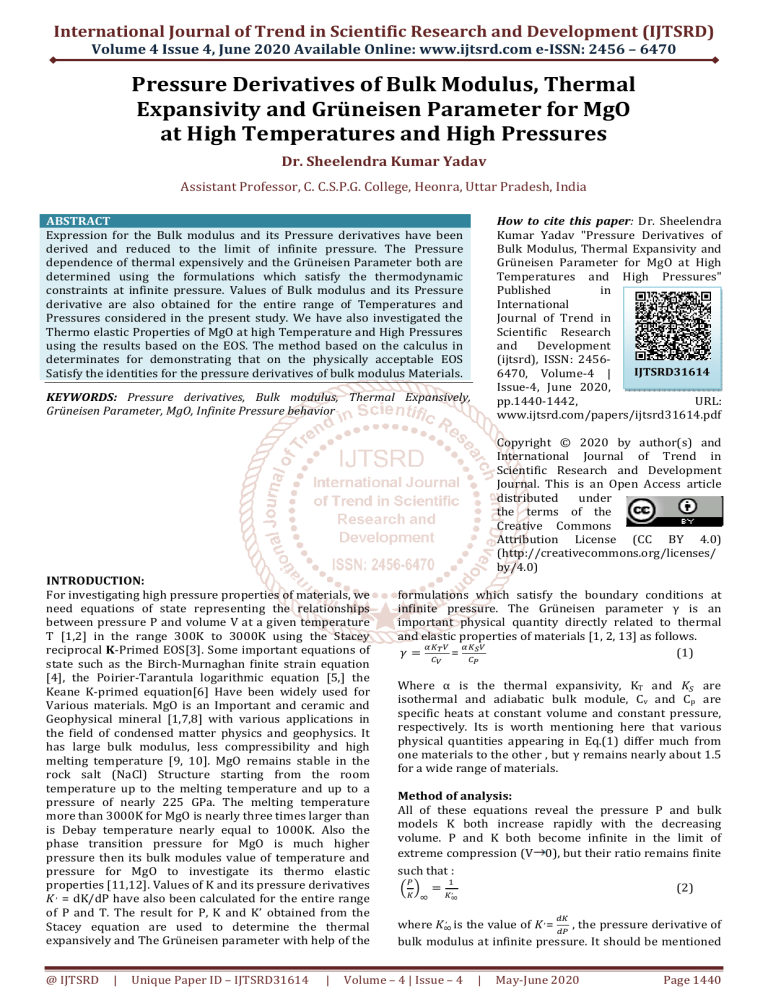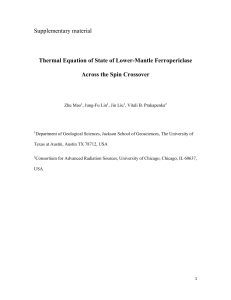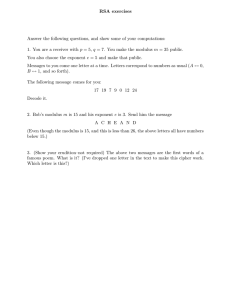
International Journal of Trend in Scientific Research and Development (IJTSRD)
Volume 4 Issue 4, June 2020 Available Online: www.ijtsrd.com e-ISSN:
ISSN: 2456 – 6470
Pressure Derivatives off Bulk Modulus, Thermal
Expansivity and
a Grüneisen Parameter for MgO
at High Temperatures and
nd High Pressures
Dr. Sheelendra Kumar Yadav
Assistant Professor, C. C.S.P.G. College, Heonra, Uttar Pradesh,, India
ABSTRACT
Expression for the Bulk modulus and its Pressure derivatives have been
derived and reduced to the limit of infinite pressure. The Pressure
dependence of thermal expensively and the Grüneisen Parameter both are
determined using the formulations which satisfy
satisf the thermodynamic
constraints at infinite pressure. Values of Bulk modulus and its Pressure
derivative are also obtained for the entire range of Temperatures and
Pressures considered in the present study. We have also investigated the
Thermo elastic Properties
erties of MgO at high Temperature and High Pressures
using the results based on the EOS. The method based on the calculus in
determinates for demonstrating that on the physically acceptable EOS
Satisfy the identities for the pressure derivatives of bulk modulus
mo
Materials.
How to cite this paper:
paper Dr. Sheelendra
Kumar Yadav "Pressure Derivatives of
Bulk Modulus, Thermal Expansivity and
Grüneisen Parameter for MgO at High
Temperatures and High Pressures"
Published
in
International
Journal of Trend in
Scientific Research
and
Developm
Development
(ijtsrd), ISSN: 24562456
IJTSRD31614
6470, Volume-4
Volume
|
Issue-4,
4, June 2020,
pp.1440-1442,
1442,
URL:
www.ijtsrd.com/papers/ijtsrd31614.pdf
KEYWORDS: Pressure derivatives, Bulk modulus, Thermal Expansively,
Grüneisen Parameter, MgO, Infinite Pressure behavior
Copyright © 2020
20
by author(s) and
International Journal of Trend in
Scientific Research and Development
Journal. This is an Open Access article
distributed
under
the terms of the
Creative Commons
Attribution License (CC BY 4.0)
(http://creativecommons.org/licenses/
by/4.0)
INTRODUCTION:
For investigating high pressure properties of materials, we
need equations of state representing the relationships
between pressure P and volume V at a given temperature
T [1,2] in the range 300K to 3000K
K using the Stacey
reciprocal K-Primed
Primed EOS[3]. Some important equations of
state such as the Birch-Murnaghan
Murnaghan finite strain equation
[4], the Poirier-Tarantula
Tarantula logarithmic equation [5,] the
Keane K-primed equation[6] Have been widely used for
Various materials.
als. MgO is an Important and ceramic and
Geophysical mineral [1,7,8] with various applications in
the field of condensed matter physics and geophysics. It
has large bulk modulus, less compressibility and high
melting temperature [9, 10]. MgO remains stable in the
rock salt (NaCl) Structure starting from the room
temperature up to the melting temperature and up to a
pressure of nearly 225 GPa. The melting temperature
more than 3000K for MgO is nearly three times larger than
is Debay temperature nearly equal to 1000K. Also the
phase transition pressure for MgO is much higher
pressure then its bulk modules value of temperature and
pressure for MgO to investigate its thermo elastic
properties [11,12]. Values of K and its pressure derivatives
, = dK/dP have also been calculated for the entire range
of P and T. The result for P, K and K’ obtained from the
Stacey equation are used to determine the thermal
expansively and The Grüneisen parameter with help of the
@ IJTSRD
|
Unique Paper ID – IJTSRD31614
31614
|
formulations which satisfy the boundary
bou
conditions at
infinite pressure. The Grüneisen parameter γ is an
important physical quantity directly related to thermal
and elastic properties of materials [1, 2, 13] as follows.
=
(1)
Where α is the thermal expansivity,
expan
KT and are
isothermal and adiabatic bulk module, Cv and Cp are
specific heats at constant volume and constant pressure,
respectively. Its is worth mentioning here that various
physical quantities appearing in Eq.(1) differ much from
one materials
als to the other , but γ remains nearly about 1.5
for a wide range of materials.
Method of analysis:
All of these equations reveal the pressure P and bulk
models K both increase rapidly with the decreasing
volume. P and K both become infinite in the limit of
extreme compression (V 0), but their ratio remains finite
such that :
,
∞
(2)
∞
where ∞, is the value of , = , the pressure derivative of
bulk modulus at infinite pressure. It should be mentioned
Volume – 4 | Issue – 4
|
May-June 2020
Page 1440
International Journal of Trend in Scientific Research and Development (IJTSRD) @ www.ijtsrd.com eISSN: 2456-6470
that , represents the role of increase of bulk modulus
with the increase in pressure. The Brich –Murnaghan EOS ,
the Poirier-Tarantola logarithmic EOS , and the
generalized Rydberg- Vinet EOS, all can be represented by
the following common formula:
=
∞,
The reciprocal gamma relationship can be written as
follows
3
+ Where f(x) is a function of x= V/V0 V0 is the value of
volume V at P=0 of K’ and f(x) are different for different
EOS. Thus for the Birch-Murnaghan fourth order EOS, K’=
11/3, and
The Stacey reciprocal K-primed equation of state is
wriiten as follows [3]
,
=
,
+ 1 +
,
∞
,
(4)
Equation (4) represents a linear relationship between 1/K’
and P/K such that [14].
,
∞
=
(5)
∞
The subscripts 0 and
represent values at zero - pressure
and at infinite pressure, respectively. Eq. (4) has been
integrated analytically [10, 11] to find
,
= 1−
,
∞, ∞
(6)
Eq. (6) has also been integrated to yield [8, 10]
In
=
′
,!
∞
"# 1 − ′∞ +(
,
′∞
− 1
(7)
For determining values of thermal expansivity α at
different pressure along elected isotherm we use the
formulation [12] which satisfies the thermodynamics
constraints [10] according to which the thermal
expansivity vanishes in the limit of infinite pressure.
Values of Gr neisen parameter γ relationship recently
formulated by shanker at al. [13]. This formulation yields
satisfactory results for the Earth lower , mantel and core in
good agreement with the seismic data [10].
The formulation used for α (P) is written as follows [12]
$ = $% (1- , P/K) t
of α using Eq.(8) which is consistent with the
thermodynamic constraints that α tends to zero in the
limit pressure [2,13] Eq. (5) at infinite pressure when used
in Eq. (8) gives α equal zero.
(8)
where $% is the thermal expansivity α at zero pressure. t is
a material dependent constant. We have calculated values
&
=
&
+ ′∞
&∞
− &
(9)
Where γ0 and ∞ are respectively the values of γ at zero
pressure in the limit of infinite pressure.\
Result and Discussions
It should be emphasized that the pressure derivatives of
bulk modulus are of central importance for determining
thermoplastic properties of materials lat high pressure
and high temperatures. The formulation presented here is
related to different equations of state which have been
used recently for investigating properties of materials at
high pressure. for investigating the pressure-volume
relationship at high temperatures , the thermal pressure is
of central importance [1, 15, 16]. We can determine
thermal pressure by lowing the values of thermal
expensivity and bulk modulus at high temperatures
[7,8,14] An alternative method for determining pressurevolume relationship at higher temperatures has been
developed [7,8,15] using phenomenological equation of
state with temperatures dependent values of input
parameters K0 and %, . For MgO,
Conclusions:
We have used the Stacey reciprocal K-primed equation of
state which satisfies important boundary conditions at
infinite pressure .It is found from the P-V-T results
obtained for MgO that for producing the same amount of
compression . Values of bulk modulus K increase with
the increase with the increase in pressure, and decrease
with the increase in temperature. Since the bulk modulus
is inverse of compressibility, it becomes harder to
compress the solid at higher pressures because of the
increasing bulk modulus. One of the most important
thermodynamic constraints due to Stacey [13] is the fact
that thermal expansivity of a material vanishes in the limit
infinite pressure the reciprocal gamma equation has been
shown to be compatible with the Stacey reciprocal Kprimed equation both.
The equation yield similar expression for the higher order
derivatives at infinite pressure. We may thus conclude that
status of an identity which can be used for determining the
third order Grüneisen Parameter [17].
Acknowledgements:
We are thankful to the reviewers for their helpful comments. Thanks are also due to Professor Anuj Vijay & Professor J.
Shanker, for some very useful discussions.
P(GPa)
$ at T=2000K
@ IJTSRD
|
Unique Paper ID – IJTSRD31614
0.00
5.48
|
46.30
2.48
102
1.65
154
1.23
Volume – 4 | Issue – 4
205
1.11
|
239
0.941
May-June 2020
Page 1441
International Journal of Trend in Scientific Research and Development (IJTSRD) @ www.ijtsrd.com eISSN: 2456-6470
MgO
T=2000K
3
2.5
2
$ × 10* 1.5
T=2000K
1
0.5
0
46.3
78.5
102
154
205
239
P(GPa)
REFERENCES
[1] Anderson O L, Equation of state of solid for
Geophysics and Ceramic Science (Oxford university
Press, Oxford),1995, 20
[11] S. S Kushwah, M. P. Sharma, Solids State Comm. 152,
414 (2012)\
[2] Stacey F D & Davis P M, Phys Earth Planet Inter, 142
(2004)137.
[13] Stacey F D, Rep. Prong. Phys. 68(2005)341.
[14] L. Knopoff, J Geophys. Res. 68 350 (1963)
[3] Stacey F D, Geophys J Int, 628(2000)143.
[15] J. Shanker, S. S. Kushwah, Physica B 254, 45 (1998).
[4] Birch F, J Geophys Res, 91 (1986) 4949.
[5] Poirier J P & tarantola A, Phys Earth Planet Inter, 109
(1998)1.
[7] S. Gaurav, B.S. Sharma, S.B. Srma, S.C UPADHYA, j
Phys. Chem Solids, (2004)
[8] S. Rekha, B.S. Sharma, High Tem. High Press 35, 353
(2003)
[9] M.Panwar4, S.K Sharma, S Panwar, High Temp. High
Press. 45 320. (2006)
[10] K. Sushil, K. Arunesh, P. K. Singh, B. S. Sharma,
Physics B 352, 134 (2004)
|
Unique Paper ID – IJTSRD31614
[16] J. Shanker, M. P. Sharma, S. S. Kushwah, J. Phys. Chem.
Solids60, 603 (1999).
[17] J. Shanker, P. Dulari, P.K. Singh, Physica B 404, 4085
(2009).
[6] Keane A, Aust J Phys, 7 (1954)323
@ IJTSRD
[12] P. K. Singh, Indian J. Phys. 86, 259 (2012)
|
[18] K. Sheelendra & A. Vijay, 9th National Conference on
Thermophysical Properties (NCTP-2017) 030001-1–
030001-5.
[19] Sheelendra kumar Yadav, IJTSRD Vol.4 Issue-4
(2020) pp 990-993
[20] Sheelendra kumar Yadav, IJTSRD Vol.4 Issue-4
(2020) pp 994-996
Volume – 4 | Issue – 4
|
May-June 2020
Page 1442







